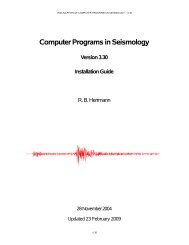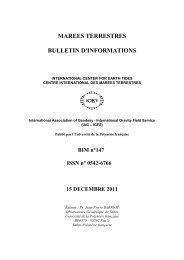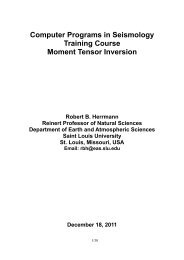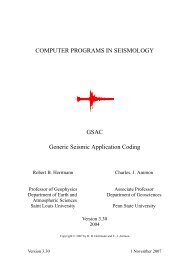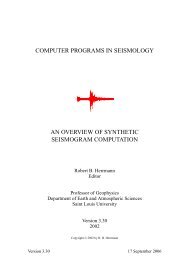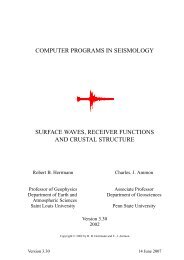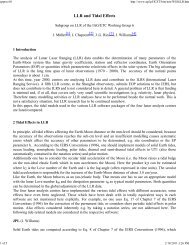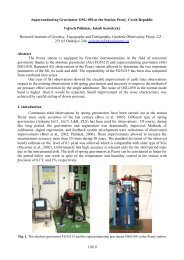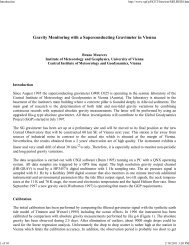3.04 Gravimetric Methods – Superconducting Gravity Meters
3.04 Gravimetric Methods – Superconducting Gravity Meters
3.04 Gravimetric Methods – Superconducting Gravity Meters
You also want an ePaper? Increase the reach of your titles
YUMPU automatically turns print PDFs into web optimized ePapers that Google loves.
98 <strong>Superconducting</strong> <strong>Gravity</strong> <strong>Meters</strong><br />
Antarctica by Japanese colleagues, in South Africa by<br />
GFZ Potsdam (Germany), and very recently in<br />
South America by BKG (Germany) <strong>–</strong> the TIGO<br />
project. Phase I of GGP was the period 1997<strong>–</strong>2003<br />
and we are currently in phase II (2003<strong>–</strong>07).<br />
The scientific objectives of the GGP cover geophysical<br />
phenomena throughout the wide period range of<br />
the instruments (from 1 s to several years), covering<br />
topics such as normal modes, mantle rheology, tides,<br />
solid Earth<strong>–</strong>oceans<strong>–</strong>atmosphere interactions, hydrology,<br />
and Earth rotation. Figure 15 represents<br />
schematically the gravity spectrum that is observable by<br />
SGs ranging from seconds (ocean noise) to several<br />
years (secular changes). We refer the reader to<br />
the EOS article by Crossley et al. (1999), where a full<br />
description is provided. Other review papers on<br />
SGs have also appeared (e.g., Goodkind, 1999;<br />
Hinderer and Crossley, 2000; Meurers, 2001a;<br />
Hinderer and Crossley, 2004). We will show below<br />
some of the most interesting results which owe their<br />
existence to the collection of the worldwide GGP data<br />
of high quality.<br />
The wide spectrum of geophysical phenomena<br />
that are observable with SGs is evident in<br />
Figure 15. Basically the range of observable periods<br />
(or characteristic time constants) covers 8 orders of<br />
magnitude from 1 s to several years. The highest<br />
frequency detectable by SGs is 1 s, because of the<br />
feedback system limitation, and on the left the figure<br />
shows background noise mainly caused by ocean<br />
noise with two dominant peaks at 5<strong>–</strong>6 s and 10<strong>–</strong>15 s.<br />
At slightly longer periods we have the seismology<br />
region including the normal modes generated by<br />
earthquakes <strong>–</strong> periods up to 54 min which is the<br />
gravest period of the Earth elastic normal modes.<br />
Between 150 and 500 s (2<strong>–</strong>7 mHz), these modes<br />
form the incessant oscillations (‘hum’) unrelated to<br />
earthquakes but rather of atmospheric and/or oceanic<br />
origin. At periods longer than about 6 h<br />
(depending on the core stability profile), another<br />
class of eigenmodes are the gravity-inertial modes<br />
(also called core modes) predominantly confined to<br />
the liquid core. A particularly interesting and isolated<br />
long-period oscillation is the Slichter mode (actually<br />
a triplet due to rotation and ellipticity) arising from<br />
translation of the solid inner core. Its period, between<br />
4 and 8 h, depends primarily on the density jump of<br />
the inner-core boundary (ICB).<br />
From 4 h up to 18.6 years, there are many spectral<br />
lines due to lunisolar tides, the most important of<br />
which are semi-diurnal and diurnal. The study of<br />
diurnal gravity tides includes a resonance effect due<br />
Surface gravity effect<br />
1 s 1 h<br />
1 day 1 month 1 year<br />
Amplitude<br />
100 μgal<br />
10 μgal<br />
1 μgal<br />
Atmosphere<br />
Groundwater<br />
ter-diurnal<br />
semidiurnal<br />
diurnal<br />
Weekly<br />
Fortnightly<br />
Monthly<br />
Semiannual<br />
Annual<br />
CW<br />
100 ngal<br />
10 ngal<br />
Ocean<br />
noise<br />
Seismic<br />
normal modes<br />
quar-diurnal<br />
Slow and silent<br />
earthquakes<br />
FCN<br />
Secular<br />
deformations<br />
1 ngal<br />
Slichter<br />
triplet?<br />
FICN?<br />
Core<br />
modes?<br />
Figure 15<br />
10 0 10 1 10 2 10 3 10 4 10 5 10 6 10 7 10 8<br />
Period (s)<br />
Characteristics of geophysical phenomena observable by SGs.




